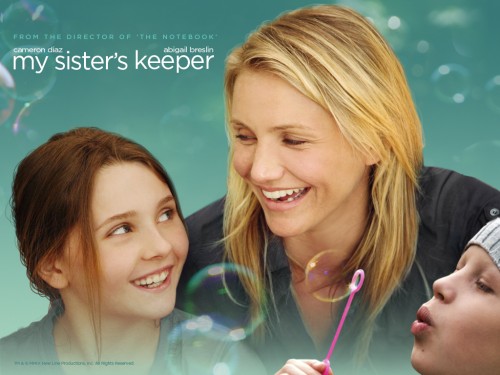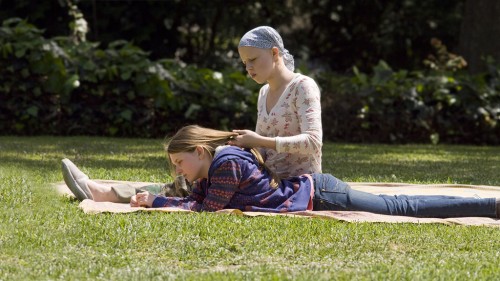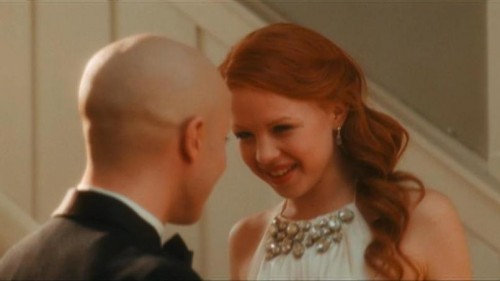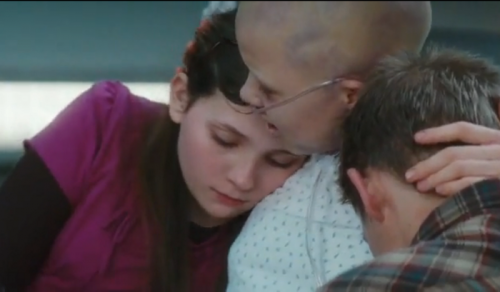Powerful Realism and Nostalgia in My So-Called Life by Leigh Kolb
Almost 20 years later, we need more of what My So-Called Life gave us a taste of. We need teenage girl protagonists to be sexual, not sexy. We need honest portrayals of what it is to be a teenager–not only for teenagers who need to see themselves in faithful mirrors, but also for adults who are still trying to figure themselves out.
Are You There, Hollywood? It’s Me, the Average Girl by Carrie Gambino
Six Lessons Lisa Simpson Taught Me by Lady T
Bob’s Burgers: The Uniquely Lovable Tina Belcher by Max Thornton
The Relationships of Veronica Mars by Sarah Stringer
It’s common wisdom that maintaining relationships requires constant work, but there’s often an assumption (in TV, movies, and real life) that this only applies to romantic relationships. Platonic relationships are rarely the focus of a story, and when a storyline deals with issues in these relationships, they’re often easily dealt with, and the friendship goes back to being simple. Exceptions to this are problems that are caused by romantic relationships. Veronica Mars is an exception to this; for its first two seasons, it depicts many platonic relationships, and explores the many issues involved in navigating them (some of these problems are related to romance, but many are not, showing platonic relationships have their own complexities, separate from romance).
Sixteen Candles, Rape Culture, and the Anti-Woman Politics of 2013 by Stephanie Rogers
So, these are the important things in Sixteen Candles: Samantha’s family forgets her birthday; she’s in love with a hot senior who’s dating Caroline (the most popular girl in school); and there’s a big ol’ geek (Farmer Ted) from Sam’s daily bus rides who won’t stop stalking her. Oh, and Long Duk Dong exists [insert racist gong sound here]. Seriously, every time Long Duk Dong appears on screen, a fucking GONG GOES OFF on the soundtrack. I suppose that lines up quite nicely with the scene where he falls out of a tree yelling, “BONSAI.”
Since the entire movie is like a machine gun firing of RACIST HOMOPHOBIC SEXIST ABLEIST RAPEY parts, the only way I know how to effectively talk about it is to look at the very problematic screenplay. So, fasten your seatbelts and heed your trigger warnings.
The 80s were quite possibly a nightmare.
Sucker Punch Might Leave You Wishing for a Lobotomy by Angelina Rodriguez
On Milk-Bones, Toothed Vaginas, and Adolescence: Teeth As Cautionary Tale by Colleen Clemens
Early in the film, Dawn is a nymph-like virgin committed to “saving herself” until marriage. She is the poster child for the “good” girl: a loving daughter who obeys the doctrines of the church and spends her time spreading the gospel of virginity. Everything Dawn knows about the world and herself changes when her falsely pious boyfriend Tobey takes her to a far off swimming hole and tries to rape her. A confused and terrified Dawn reacts by screaming and then—much to everyone’s surprise—cutting off his penis to interrupt the rape. Little does Dawn know that her lessons about Darwin in her biology classes are taking hold in her own body.
The Horror of Female Sexual Awakening: Black Swan by Rebecca Willoughby
Girl Gangs Are Mean: Teenage Girl Gang Movies Through the Years by Emanuela Betti
While most teen movies revolve around coming-of-age stories, gang movies reveal the extreme side to adolescence—the misfit, criminal, and violent side. Gang movies are rather simple, either focusing on episodes of gang debauchery, or revolving around rivalry and jealousy. Usually the viewpoint is that of the ring leader, or the “new girl,” who is initiated into the gang but is still an outsider. Yet, among the plethora of girl gang movies, every decade has produced stories involving specific issues and specific types of teenage girls.
What a Witch: Girlhood, Agency, and Community in Kiki’s Delivery Service and The Little Mermaid by Megan Ryland
Kiki’s Delivery Service carefully constructs a world where a girl’s agency is expected, accepted and supported, while Disney movies typically present a girl’s agency as unusual, forbidden, and denied. The difference between these two messages is that Kiki’s world anticipates and encourages her independence, while the women of Disney are typically punished for this.
For example, in The Little Mermaid Ariel wants to “live out of these waters,” but her father forbids her exploration of the human world and punishes this dream. Sea witch Ursula exploits Ariel’s desire to discover another world beyond her own as well. This is hardly an isolated incident.
The Book Thief: Stealing Hearts and Minds by Natalie Wilson
Liesel, unlike so many young heroines, resists romance—from her friend Rudy’s early problematic insistence and then throughout the remainder of the movie. Instead of being positioned in relationship to romantic partners, she has three male best friends—Rudy, Max and Hans (Papa)—as well as two females of great importance to her life, Rosa (Mama) and Ilsa Hermann (the mayor’s wife who, transgressively, supplyies Liesel with books). As for Liesel, like her futuristic counterpart, Katniss Everdeen, she is a life-saving heroine and inspirational rebel.
Just One of the Guys: Sexism, Gender Stereotypes, and the Rise of the Female Teenage Protagonist by Shay Revolver
Troop Beverly Hills: What A Thrill by Phaydra Babinchock
Puella Magi Madoka Magica, Declaration Feminism by Matthew Abely
Young Women and Heroism in The Host by Sade Nickels
Ten questions between filmmaker Morgan Faust and 13-year-old actress Rachel Resheff.
Morgan: The truth is when I was growing up in the 1980s, the child actresses were often given pretty syrupy roles (with the exception of Journey of Natty Gann and Labyrinth). It was the boys who got to have the cool movies–Goonies, Stand by Me, even The NeverEnding Story and E.T., which did have girls, but the boys were the heroes. That is why I write the movies I do–adventures films for girls–because that’s what I wanted to do when I was a kid, go on adventures, be the hero. I still do want that. I mean, who doesn’t?
Catching Fire: Positive Fuel for the Feminist Flame by Natalie Wilson
The Hunger Games, saturated as it is with political meaning (the author admits her inspiration for the trilogy came from flipping channels between reality TV and war footage), is a welcome change from another recent popular YA series, Twilight. As a further bonus, it has disproven the claim that series with female protagonists can’t have massive cross-gender appeal. With the unstoppable Katniss Everdeen at the helm (played in the films by the jaw-droppingly talented Jennifer Lawrence), perhaps the series will be the start of a new trend: politically themed narratives with rebellious female protagonists who have their sights set on revolution more than love, on cultural change more than the latest sparkling hottie.
The CW: Expectations vs. Reality by Nicole Elwell
The CW is a rarity among the many networks of cable television. Its target demographic is women aged 18-34, and as a result has a majority of its original programming centered on the lives of young women. On paper, this sounds like a noteworthy achievement to be celebrated. However, the CW produces content devoid of any sense of the reality of its young audience, and as a result actually harms its most devoted viewers. The CW creates an unattainable archetype for what a teenager should look like and fails to maturely handle issues of murder and rape.
Defending Dawn Summers: From One Kid Sister to Another by Robin Hitchcock
OK, sure, my big sister didn’t have superpowers, and as far as I know she did not save the world even one time, much less “a lot.” But from my perspective as her bratty little sister, I felt like I could never escape her long and intimidating shadow. I could never be as smart as her, as special as her; I couldn’t hope to collect even a fraction the awards and accolades she racked up through high school. And she didn’t even properly counteract her super smarts with social awkwardness: she always had a tight group of friends and the romantic affections of cute boys. She was the pride and joy of my family, and I always felt like an also-ran. Trust me: this makes it very hard to not be at least a little bratty and whiny.
Why Alex Russo Is My Favorite Fictional Female Wizard by Katherine Filaseta
The protagonist of Wizards is a girl who acts like girls really act: she has boyfriends and broken hearts, but isn’t overly boy-crazy or dependent on them; she’s curious and smart enough to ask questions when other people are telling her not to; and throughout the series she faces a lot of the struggles women really do face throughout their lives.
Ja’mie: Mean-Spirited Impression of a Private School Girl by Katherine Murray
True Grit: Ambiguous Feminism by Andé Morgan
True Grit: The Formidable Fortitude of Tweens by Vicky Moufawad-Paul
Princess Mononoke Has No Desire to Marry a Prince by Jen Thorpe
Granted, Ashitaka (voiced by Billy Crudup) is an important character. Even so, it is a bit disconcerting when the IMDb blurb about this movie only mentions him, and almost none of the female characters who are equally, if not more, important to the story. Princess Mononoke (voiced by Claire Danes) is the title character, but is only mentioned toward the end of the blurb. This movie is so much more than yet another “save the princess” quest!
Pretty in Pink: Side Effects from the Prom by Kim Hoffman
Temporary Tomboys: Coming of Age in My Girl and Now and Then by Elizabeth Kiy
However, the tomboy was a prominent figure in two well-loved films of the period aimed at young girls, though both presented her as a transitional stage in development. My Girl (1991), is the story of precocious 11-year-old Vada Sultenfuss (Anna Chlumsky) who grew up in a funeral parlor and is obsessed with death, while in Now and Then (1995) four childhood friends reunite as adults and remember (in flashbacks) the summer they were 12.
Brave and the Legacy of Female Prepubescent Power Fantasies by Amanda Rodriguez




